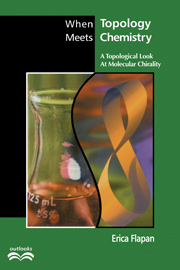5 - Intrinsic Topological Properties of Graphs
Published online by Cambridge University Press: 05 June 2012
Summary
We have discussed the concept of intrinsic chirality in Chapters 3 and 4, and we have seen various examples of molecular graphs and cell complexes that are intrinsically chiral. Recall that we call such graphs intrinsically chiral because their chirality is an intrinsic property of the graphs rather than a result of how the graphs are embedded in ℝ3 or S3. Although there are many other intrinsic properties of abstract graphs, we are interested in those properties that tell us something about the topology of all possible embeddings of the graphs in ℝ3 or S3. One class of graphs that has several intrinsic topological properties is the class of complete graphs. We saw before that a complete graph on n vertices, denoted by Kn, is defined to be n vertices together with edges connecting every pair of vertices. For example, in Chapter 1 we saw the graph of the Simmons–Paquette molecule. This graph (illustrated in Figure 5.1) has the form of a K5 together with some additional vertices of valence two.
Liang and Mislow (1994a) have listed many other molecules, including a protein molecule, whose graphs also contain a K5. Thus far, no molecule has been synthesized whose molecular graph is Kn for n > 5. Sritana-Anant, Seiders, and Siegel (1998) have proposed the graph K6 as well as other complex graphs as targets for future molecular design and synthesis. Thus we expect that in the future we will see a molecular K6.
- Type
- Chapter
- Information
- When Topology Meets ChemistryA Topological Look at Molecular Chirality, pp. 136 - 160Publisher: Cambridge University PressPrint publication year: 2000



